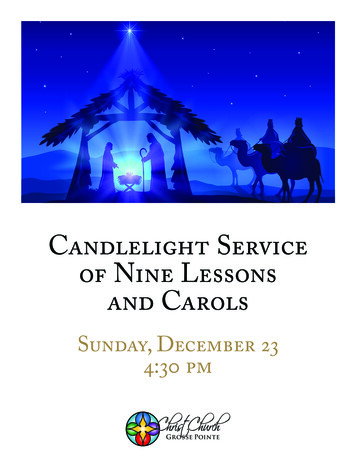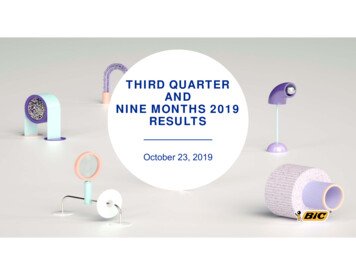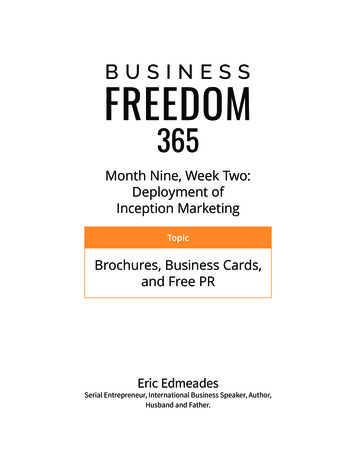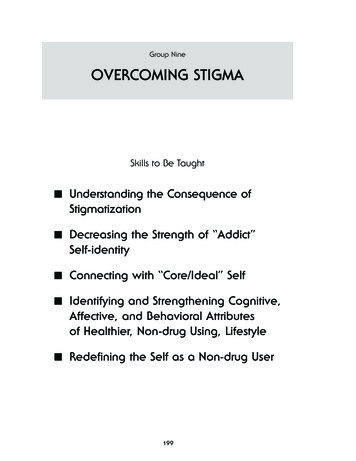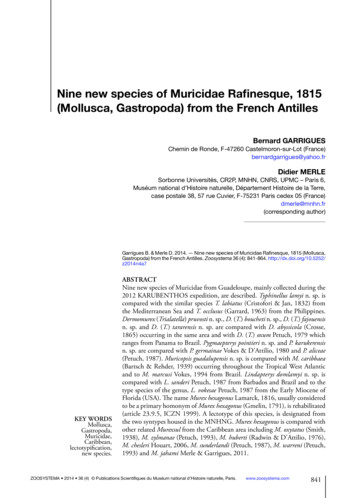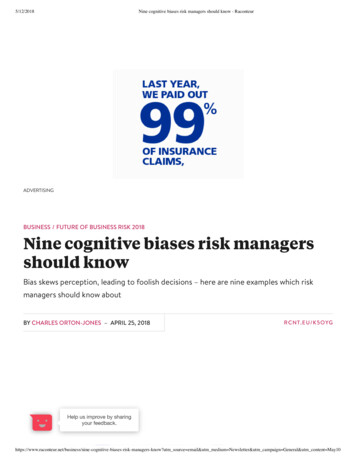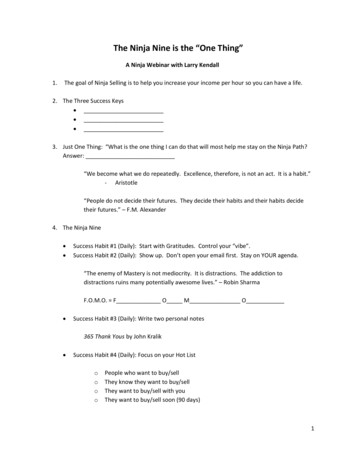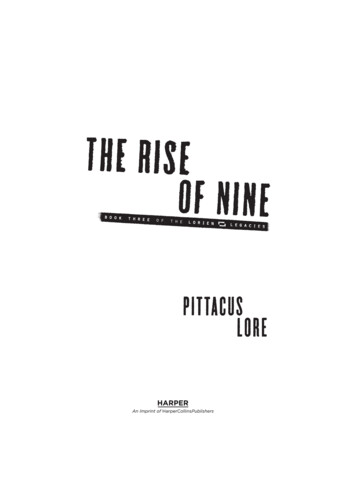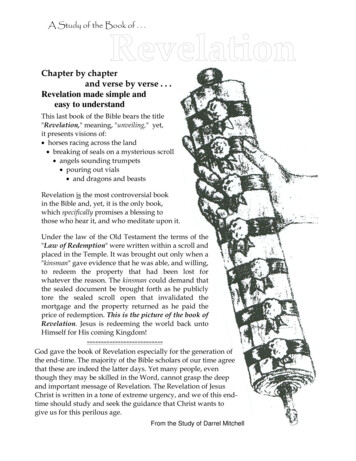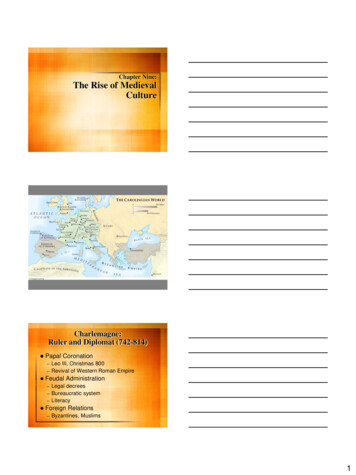
Transcription
Chapter Nine:The Rise of MedievalCultureCharlemagne:Ruler and Diplomat (742-814) Papal Coronation–– Leo III, Christmas 800Revival of Western Roman EmpireFeudal Administration–Legal decreesBureaucratic system– Literacy– Foreign Relations–Byzantines, Muslims1
Charlemagne:Economic Developments Stabilized the currency–Denier Trade Fairs Tolerance of Jews Jewish merchants and the Near East Trade Routes Import / Export Relationships–Iron BroadswordsLearningin the Time of Charlemagne“Palace School” at AachenScholar-teachers Curriculum ––Trivium, quadriviumMastery of texts Text reform Literacy as prerequisite for worship–Literary revival Liturgical revivalLearningin the Time of Charlemagne Alcuin of York–– Corrected errors in the Vulgate BibleDeveloped Frankish school systemLiteracy and Women––DhoudaIlluminated manuscripts2
Benedictine Monasticism Early monasticism–– Varying monastic lifestylesNo predominate ruleThe Rule of St. Benedict“Magna Carta of monasticism”Poverty, stability, obedience, chastity– Balance of prayer, work, and study– Horarium––Women and the Monastic Life Scholastica (d. 543) Brigit of Ireland (d. 525)Hilda, abbess of Whitby (614-680)Hildegard of Bingen (1098-1179)–St. Benedict’s sisterMonasticismand Gregorian Chant Development of sacred music–Gregorian ChantAmbrosian music– Mozarabic chant– Frankish chant–3
Monasticismand Gregorian Chant Gregorian chant and Carolingian reformGregorian characteristics–MonophonicMelismatic– Acapella– Cantus planus– neums–Liturgical Musicand the Rise of Drama The Liturgical Trope–Verbal elaborations of textual contentAdded to the long melismas– Aid in memorization– Origin of drama in the West– QuemQuæritisMedieval Literature Venerable Bede–– Father of English historyEcclesiastical History of the EnglishPeopleBeowulfHildegard of Bingen–Writer, painter, illustrator, musician, critic,preacher– Scivias, Physica, Causae et Curae,Symphonia, Ordo Virtutum4
9.1 Hildegard of Bingen, “Vision of God’s Plan for the Seasons,” fromDe operatione Dei, 1163-1174The Morality Play: Everyman Links liturgical and secular dramaAllegorical, moralistic Religious themes–Instructs for moral conversion–Life as a pilgrimageThe inevitability of death (memento mori)– Faith vs. Free Will– Liturgical overtonesThe Legend of Charlemagne:Song of Roland Charlemagne canonized 1165 Epic poem––Reliquaries and commemorativesCharlemagne’s battle with the Basques(778)–Chansons de geste, chansons d’histoire Oral tradition, jongleursMilitary and religious ideals Anti-Muslim bias–11th c. martial virtues and chivalric code5
9.23 Reliquary of CharlemagneThe Visual Arts:The Illuminated Book Carolingian manuscripts on parchmentGospel Book of Charlemagne Utrecht Psalter Dagulf Psalter Carolingian miniscule–––Roman, Byzantine, Celtic stylesMasterpiece of the Carolingian RenaissanceCarved ivory book covers9.9 The fourevangelists and theirsymbols, PalatineSchool at Aachen,early 9th century.Manuscriptillustration from theGospel Book ofCharlemagne6
9.10 Drawing for Psalm 150 from the Utrecht Psalter, ca820-8409.11 Crucifixion,ca. 860-870,carved ivorypanel, Victoriaand AlbertMuseum, London,United KingdomCarolingian ArchitectureCharlemagne’s Palace at Aachen Kingdom modeled on ancient RomePalace–– Chapel––– Large royal hall, lavishly decoratedJoined to chapel by a long galleryChurch of San Vitale (Ravenna) as modelAltar to the Savior (liturgical services)Chapel to the Virgin (reliquary)Charlemagne’s Throne–“ this most wise Solomon.”7
The Carolingian Monastery Monastery as “miniature civic center”–– Complexity of function and designCenter of life for rural populationsSaint Gall plan––Basilica styleDesigned to house 120 monks, 170 serfsThe Romanesque Style Large, “Roman-looking” architectureInfluenced by travel, expansion Heavy stone arches –Pilgrimages–Larger, more spacious interiorsFireproof stone and masonry roofs– Church of Saint Sernin in Toulouse–9.19 Nave, Saint Sernin, ca 1020-1180, Toulouse,France8
The Romanesque Style Exterior decoration (sculpture)–Lack of interior lightPortal (doorway)– Jamb, capital, trumeau– Tympanum (mandorla, archivolts)– Churchof Sainte Madeleine at Vézelay9.20 Cathedral of Sainte-Lazare, west tympanumdetail of Last Judgment, ca 1120-1135Chapter 9: Discussion Questions Explain the function of the Song of Roland as bothreligious and political propaganda during theeleventh and twelfth centuries. What values areextolled within the text that would serve religiousand political leaders as they shape their culture? Dowe, as a culture, subscribe to these same valuestoday? Why or why not?Why was Charlemagne so interested in developingliteracy? Explain his motives and methods forestablishing schools and supporting scholars.Describe the role of the liturgical trope in thedevelopment of drama in the West. For example,how does one begin with the Quem Quæritis tropeand arrive at Everyman? Explain the evolution of theart form.9
1 Chapter Nine: The Rise of Medieval Culture Charlemagne: Ruler and Diplomat (742-814) Papal Coronation – Leo III, Christmas 800 – Revival of Western Roman Empire Feudal Administration – Legal decrees – Bureaucratic
